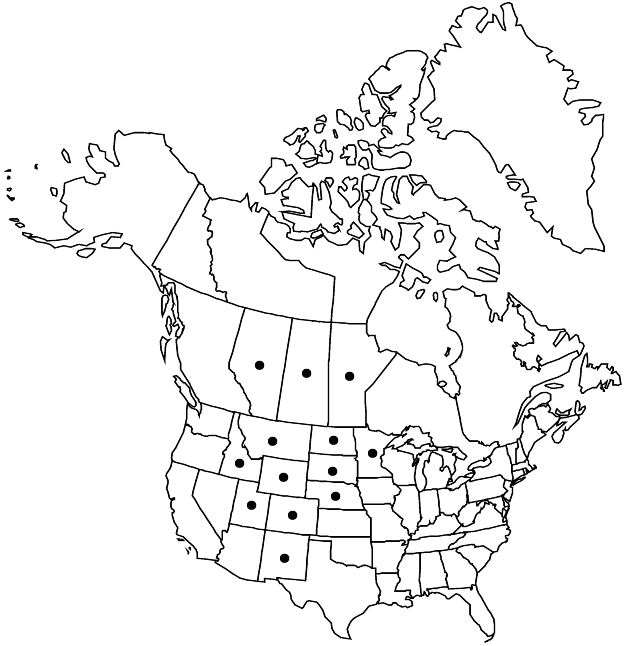Difference between revisions of "Potentilla effusa"
Nov. Stirp. Pug. 2: 8. 1830.
FNA>Volume Importer |
RevisionBot (talk | contribs) m (Bot: Adding category Revised Since Print) |
||
| (4 intermediate revisions by 3 users not shown) | |||
| Line 34: | Line 34: | ||
-->{{Treatment/Body | -->{{Treatment/Body | ||
| − | |distribution= | + | |distribution=Alta.;Man.;Sask.;Colo.;Idaho;Minn.;Mont.;N.Dak.;N.Mex.;Nebr.;S.Dak.;Utah;Wyo. |
|discussion=<p>Varieties 2 (2 in the flora).</p><!-- | |discussion=<p>Varieties 2 (2 in the flora).</p><!-- | ||
--><p>In the southern Rocky Mountains, <i>Potentilla effusa</i> is relatively distinct from <i>P. hippiana</i> both morphologically and geographically, with <i>P. effusa</i> mostly east of the Continental Divide and <i>P. hippiana</i> mostly west. In general, <i>P. hippiana</i> differs from <i>P. effusa</i> in having leaflets more evenly paired, more tightly serrate with teeth often occurring on the whole margin, and more bicolored with abaxial vestiture of crisped rather than cottony hairs. Stems of <i>P. effusa</i> have more cauline leaves on average than <i>P. hippiana</i>, and vestiture of epicalyx bractlets of <i>P. effusa</i> (as here circumscribed) is never sericeous.</p><!-- | --><p>In the southern Rocky Mountains, <i>Potentilla effusa</i> is relatively distinct from <i>P. hippiana</i> both morphologically and geographically, with <i>P. effusa</i> mostly east of the Continental Divide and <i>P. hippiana</i> mostly west. In general, <i>P. hippiana</i> differs from <i>P. effusa</i> in having leaflets more evenly paired, more tightly serrate with teeth often occurring on the whole margin, and more bicolored with abaxial vestiture of crisped rather than cottony hairs. Stems of <i>P. effusa</i> have more cauline leaves on average than <i>P. hippiana</i>, and vestiture of epicalyx bractlets of <i>P. effusa</i> (as here circumscribed) is never sericeous.</p><!-- | ||
| Line 66: | Line 66: | ||
|basionyms= | |basionyms= | ||
|family=Rosaceae | |family=Rosaceae | ||
| − | |distribution= | + | |distribution=Alta.;Man.;Sask.;Colo.;Idaho;Minn.;Mont.;N.Dak.;N.Mex.;Nebr.;S.Dak.;Utah;Wyo. |
|reference=None | |reference=None | ||
|publication title=Nov. Stirp. Pug. | |publication title=Nov. Stirp. Pug. | ||
|publication year=1830 | |publication year=1830 | ||
|special status=Endemic;Illustrated | |special status=Endemic;Illustrated | ||
| − | |source xml=https:// | + | |source xml=https://bitbucket.org/aafc-mbb/fna-data-curation/src/2e0870ddd59836b60bcf96646a41e87ea5a5943a/coarse_grained_fna_xml/V9/V9_236.xml |
|subfamily=Rosaceae subfam. Rosoideae | |subfamily=Rosaceae subfam. Rosoideae | ||
|tribe=Rosaceae tribe Potentilleae | |tribe=Rosaceae tribe Potentilleae | ||
| Line 79: | Line 79: | ||
}}<!-- | }}<!-- | ||
| − | -->[[Category:Treatment]][[Category:Potentilla sect. Leucophyllae]] | + | --> |
| + | |||
| + | [[Category:Treatment]] | ||
| + | [[Category:Potentilla sect. Leucophyllae]] | ||
| + | [[Category:Revised Since Print]] | ||
Latest revision as of 18:09, 6 November 2020
Stems (0.5–)1.5–4(–5.5) dm, lengths 2–3(–4) times basal leaves. Basal leaves pinnate, (3–)5–15(–25) cm; petiole 0.5–5(–8) cm, long hairs absent to abundant, ± appressed, 1–3 mm, stiff to weak, short and crisped hairs absent or obscured, cottony hairs abundant (at least on first-formed leaves), glands sparse or obscured; leaflets not conduplicate, lateral ones evenly to unevenly paired, 2–5(–7) per side (secondary leaflets sometimes interspersed) on distal 1/3–1/2 of leaf axis, distal pairs usually not decurrent or confluent with terminal leaflet, larger leaflets oblanceolate to narrowly obovate, 1–2.5(–3) × 0.3–1.3(–1.8) cm, distal (1/2–)2/3–3/4 (rarely more) of margin incised ± 1/2 to midvein, teeth (1–)2–9 per side, 1–4 mm, surfaces similar, gray to white or ± green, abaxial: long hairs sparse to common (at least on veins), 0.5–1.5 mm, weak to stiff, short or crisped hairs absent or sparse, sometimes obscured, cottony hairs absent or sparse to dense, glands absent, sparse, or obscured, adaxial: long hairs absent or sparse to common, short or crisped hairs absent or sparse, cottony hairs absent or sparse to abundant, glands absent or sparse. Cauline leaves 2–6+. Inflorescences 7–30-flowered. Pedicels 0.3–3 cm. Flowers: epicalyx bractlets linear to narrowly lanceolate, 1–2.5(–3) × 0.3–1 mm, 1/2–2/3 as long as sepals, abaxial vestiture often much sparser than sepals, often glabrate or glabrescent distally, straight hairs absent or sparse, cottony hairs usually abundant (at least proximally), sometimes absent or nearly so (var. rupincola); hypanthium 2–6 mm diam.; sepals 3–6(–7) mm, apex long acuminate; petals 4–6.5 × 4–6 mm; filaments 1–3.5 mm, anthers 0.5–1 mm; carpels 3–15, styles 1.5–2.1 mm. Achenes 1.8–2.1 mm, smooth.
Distribution

Alta., Man., Sask., Colo., Idaho, Minn., Mont., N.Dak., N.Mex., Nebr., S.Dak., Utah, Wyo.
Discussion
Varieties 2 (2 in the flora).
In the southern Rocky Mountains, Potentilla effusa is relatively distinct from P. hippiana both morphologically and geographically, with P. effusa mostly east of the Continental Divide and P. hippiana mostly west. In general, P. hippiana differs from P. effusa in having leaflets more evenly paired, more tightly serrate with teeth often occurring on the whole margin, and more bicolored with abaxial vestiture of crisped rather than cottony hairs. Stems of P. effusa have more cauline leaves on average than P. hippiana, and vestiture of epicalyx bractlets of P. effusa (as here circumscribed) is never sericeous.
The distinction between the two species is marred by intermediate populations throughout their shared range in the northern Rocky Mountains and Great Plains. Most regional floras focused on these areas have accordingly included Potentilla effusa within P. hippiana, sometimes without infraspecific distinction. An alternate solution has been the recognition of P. hippiana subsp. effusa, with the subspecies further subdivided into the two varieties recognized here. The varieties themselves intergrade; P. effusa var. ×coloradensis (Rydberg) Th. Wolf is available for the hybrid.
Selected References
None.
Key
| 1 | Leaflets gray to white, surfaces moderately long-hairy and moderately to densely cottony. | Potentilla effusa var. effusa |
| 1 | Leaflets ± green, surfaces glabrous or sparsely to moderately long-hairy (at least on veins) and not or sparsely cottony. | Potentilla effusa var. rupincola |